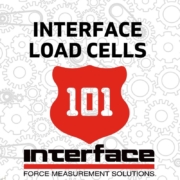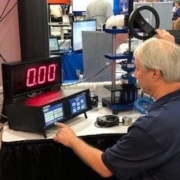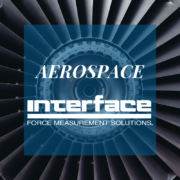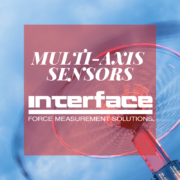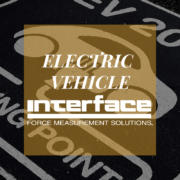The Power Combo of Multi-Axis Sensors Plus Instrumentation
 Multi-axis load cells are redefining modern testing and measurement. They provide comprehensive multidirectional force data on a single test object. These sensors provide valuable insights into complex loading scenarios, enabling engineers to confidently design, optimize, and validate their products.
Multi-axis load cells are redefining modern testing and measurement. They provide comprehensive multidirectional force data on a single test object. These sensors provide valuable insights into complex loading scenarios, enabling engineers to confidently design, optimize, and validate their products.
Interface is a leading provider of high-quality multi-axis load cells, offering many options to meet your specific testing needs. Our selection includes various configurations, capacities, and models. Learn more about the models and capabilities in Get Acquainted with Interface’s Expanding Line of Multi-Axis Sensors. Use Interface’s Multi-Axis Sensor Selection Guide to review model options.
Why Choose Multi-Axis Sensors? Traditional single-axis load cells measure force along a single axis, but multi-axis load cells simultaneously capture measurements in multiple directions. This capability offers several key advantages:
- Consolidated Measurement Signals and Space Conservation: Instead of using multiple single-axis load cells, a single multi-axis sensor can capture all the necessary data, simplifying your setup and saving valuable test space.
- Measurement of Unwanted System Crosstalk: Multi-axis sensors can identify and quantify crosstalk, or unintended interactions, between different loading axes, providing a more accurate representation of system behavior.
- Quantification of Reaction Loads: Multi-axis sensors measure forces and torques on both sides of the test article, providing a complete picture of load transfer and distribution.
- Robust Fatigue Testing: Accurate load verification through multi-axis measurement ensures that fatigue tests are conducted under the intended conditions, leading to more reliable results.
- Enhanced Data and Understanding: The comprehensive data provided by multi-axis sensors allows for a deeper understanding of system behavior, leading to better designs and more robust products.
Multi-Axis Sensors and Instrumentation Designed to Capture More Data
In addition to our extensive line of multi-axis sensors, we offer various instrumentation solutions to pair with them for advanced test and measurement systems. Our sensors and instrumentation are offered with calibration and system set-up. Multi-axis instrumentation paired with multi-axis sensors provides robust measurement systems that simultaneously capture data across multiple axes or dimensions. These load cell systems are crucial in engineering, robotics, medical research, industrial automation, and aerospace, where understanding complex forces is essential.
TIP: Check out the New Interface Multi-Axis Instrumentation Overview.
Interface offers a range of multi-axis instruments with varying channel options and configurations, from full data acquisition systems to wireless data loggers. These instruments are compatible with analog and digital outputs and come in various forms, including portable and benchtop models.
The data acquisition process involves capturing force data in three-dimensional space using multi-axis load cells. Key components include the load cell, signal conditioner, data acquisition system, and communication interface.
Multi-Axis Sensors and Instrumentation Application Use Cases
Multi-axis load cells find applications in a wide range of industries and testing scenarios, including:
Manufacturing: Monitoring forces and torques in machining, assembly lines, and material testing. A manufacturer wants to test the amount of force it takes to cut through different metal thicknesses on their metal press cutting machine. They want to ensure their metal press cutting machine and its maximum limitations work properly. Interface suggests installing their 3-axis Force Load Cell underneath the plate where pieces of metal are placed to be cut or punched holes in. When connected to the BX8-HD44 BlueDAQ Series Data Acquisition System, the force results of different metals being cut will be displayed, graphed, and recorded on the customer’s PC. It also has an analog output that can connect to the machine’s PLC in case of an overload.
Biomechanics: Measuring forces and torques in joints, implants, and prosthetics to improve design and performance. A medical research facility wants to know how a prosthetic foot responds as it is loaded during different stances for future consumers. Interface’s 3A120 3-Axis Load Cell was installed between the leg socket and the prosthetic foot. The 3A120 was then connected to the BSC4D Multi-Channel Bridge Amplifier and PC Interface Module. Read more.
Robotics: Measuring forces and torques exerted by robotic arms and grippers for precise control and manipulation. When a manufacturer needs force sensors during the testing process of their continuum robots, the 6A40 6-Axis Standard Capacity Load Cell is installed at the base of the bending segments of the continuum robot’s arm. Push and pull rods are connected and threaded through the arm multiple washers, and the load cell measures the forces of all axes when the continuum arm operates and moves. Read more.
Automotive: Evaluating forces and moments on vehicle components like suspension systems, steering mechanisms, and chassis during various driving conditions. They are also used for gathering data in crash wall testing. A vehicle testing facility needs to measure the force of the vehicle crash tests on all axes. Interface suggests using multiple 3A400 3-Axis Force Load Cells and attaching them to the back of a cement crash wall. When connected to the BX8-HD44 Interface BlueDAQ Series Data Acquisition System, force result measurements are recorded and displayed on a computer. Read more.
Aerospace: Testing aircraft structures, control surfaces, and landing gear under different flight loads. As space exploration continues to grow and evolve, more robotic systems are created to collect samples of objects and materials on planetary surfaces. Robotic arms with sampling tools must be tested for scooping, drilling, and collecting samples. Interface’s Model 6A40 6-Axis Load Cell can be installed between the flange and the sample collecting tool. When connected to the BX8-HD44 Data Acquisition, the customer can receive force and torque measurements when connected to their control system using BlueDAQ software. Read more.
Medical Robots: Surgical robotics must articulate precisely, whether in lab testing, during surgery, or for research. Radiosurgery robots target abnormalities and deliver radiation with minimally invasive precision and accuracy. Interface’s 6A40A 6-Axis Load Cell can be installed at the joints of the radiosurgery robot. The force and torque exerted must be monitored to ensure each joint can handle the precise movements and loads without failing. These results can be logged, displayed, and measured when connected to Interface’s BX8-HD44 BlueDAQ Series Data Acquisition System with included BlueDAQ software. Read more.
Interface can tailor multi-axis sensors to your unique application requirements, ensuring optimal performance and compatibility. Interface sensors are known for their exceptional accuracy and long-term reliability, providing consistent and trustworthy data. Interface’s experienced engineers can assist you with sensor selection, installation, and technical support.
By choosing Interface multi-axis load cells and instrumentation products, you can enhance your testing capabilities, gain deeper insights into your products, and make more informed engineering decisions.
Multi-Axis Instrumentation BrochureADDITIONAL RESOURCES
Using Multi-Axis Sensors To Bring Robotics To Life
Mounting Tips For Multi-Axis Sensors
BX8-HD44 BlueDAQ Series Data Acquisition System For Multi-Axis Sensors With Lab Enclosure
Enhancing Friction Testing With Multi-Axis Sensors
Recap Of Inventive Multi-Axis And Instrumentation Webinar
Interface Multi-Axis Sensor Market Research
Dimensions of Multi-Axis Sensors Virtual Event Recap
Better Data and Performance with Interface Multi-Axis Sensors
